Skipping rope

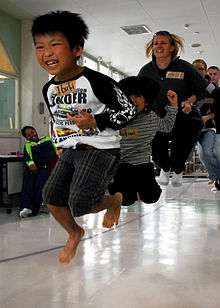
A skipping rope (British English) or jump rope (American English) is a tool used in the sport of skipping/jump rope where one or more participants jump over a rope swung so that it passes under their feet and over their heads. There are multiple subsets of skipping/jump rope including: single freestyle, single speed, pairs, three person speed (double dutch), and three person freestyle (double dutch freestyle). The events are often separated by sex and age. There are hundreds of competitive teams all around the world. There are a few major organisations that support jump rope as a sport as seen below, schools rarely have jump rope teams, and states do not sanction official events for high school or elementary school. In freestyle events, jumpers use a variety of basic and advanced techniques in a routine of one minute, which is judged by a head judge, content judges, and performance judges. In speed events, a jumper alternates their feet with the rope going around the jumper every time one of their feet hit the ground for 30 seconds, one minute, or three minutes. The jumper is judged on the number of times the right foot touches the ground in those times.
Skipping rope techniques
There are many techniques which can be used when skipping. These can be used individually, or combined in a series, to create a routine.
Solo participants
Basic jump or easy jump

Jump with both feet slightly apart over the rope. Beginners usually master this technique first before moving onto more advanced techniques.
Alternate foot jump (speed step)
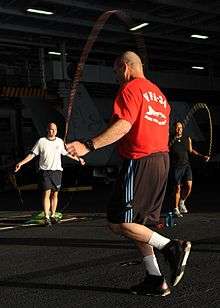
Use alternate feet to jump off the ground. This technique can be used to effectively double the number of jumps per minute as compared to the above technique. This step can be used for speed events.
Criss-cross

Also known as crossover or cross arms. Perform the basic jump whilst crossing arms in front of the body.
Side Swing
The rope is passed by the side of the participant's body, without jumping it.
EB (front-back cross or sailor)
Perform the criss-cross whilst crossing one arm behind the back.
Double under
A high basic jump, turning the rope twice under the feet. Turning the rope three times is called a triple under. In competitions, participants may attempt quadruple (quads) and quintuple unders (quins) using the same method.
Toad
Perform the criss-cross with one arm crossing under the opposite leg from the inside.
Leg over / Crougar
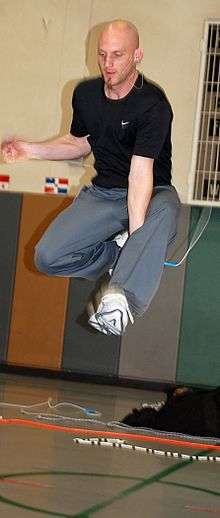
A basic jump with one arm hooked under the adjacent leg.
Awesome Annie
Also known as Awesome Anna or swish. Alternates between a leg over and a toad without a jump in between.
Inverse toad
Perform the toad whilst one arm crosses the adjacent leg from the outside.
Elephant
A cross between the inverse toad and the toad, with both arms crossing under one leg.
Frog or Donkey kick
The participant does a handstand, returns to their feet and turns the rope under them. A more advanced version turns the rope during the return to the ground.
TJ
A triple-under where the first 'jump' is a side swing, middle jump is a toad, and the final jump in an open.
Competition techniques
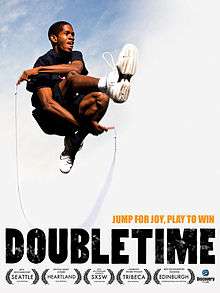
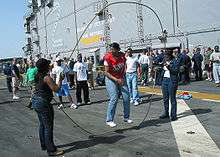
In competitions, participants are required to demonstrate competence using specific techniques. The selection required depend on the judging system and country in which the tournament is held.
Health effects
Skipping as exercise
Skipping may be used as a cardiovascular workout, similar to jogging or bicycle riding, and has a high MET or intensity level. This aerobic exercise can achieve a "burn rate" of up to 700 to over 1200 calories per hour of vigorous activity, with about 0.1 to nearly 1.1 calories consumed per jump mainly depending upon the speed and intensity of jumps and leg foldings. Ten minutes of skipping is roughly the equivalent of running an eight-minute mile. Skipping for 15–20 minutes is enough to burn off the calories from a candy bar and is equivalent to 45-60 minutes of running depending upon the intensity of jumps and leg swings. Many professional trainers, fitness experts and professional fighters greatly recommend skipping for burning fat over any other alternative exercises like running and jogging.[1]
Weighted skipping ropes are available for such athletes to increase the difficulty and effectiveness of such exercise. Individuals or groups can participate in the exercise, and learning proper techniques is relatively simple compared to many other athletic activities. The exercise is also appropriate for a wide range of ages and fitness levels.
Competition
International
There are two main world organisations: International Rope Skipping Federation (FISAC-IRSF), and the World Jump Rope Federation (WJRF). There have been 11 World Championships (FISAC), with the most recent held in Malmö, Sweden. There have been 7 World Jump Rope Championships (WJRF); the most recent taking place in Orlando, Florida. Other locations of this championship include Washington DC, France, and Portugal.
World Inter School
The first World Inter School Rope Skipping Championship was held at Dubai, November 2015.[2] The second World Inter School Rope Skipping Championship was held at Eger, Hungary.
United States
Historically in the United States there were two competing jump rope organizations: the International Rope Skipping Organization (IRSO), and the World Rope Skipping Federation (WRSF). IRSO focused on stunt-oriented and gymnastic/athletic type moves, while the WRSF appreciated the aesthetics and form of the exercise. In 1995 these two organizations merged to form the United States Amateur Jump Rope Federation (now, USA Jump Rope). USA Jump Rope hosts annual national tournaments, as well as camps, workshops, and clinics on instruction. Jump rope is also part of the Amateur Athletic Union and participates in their annual AAU Junior Olympic Games.[3][4]
See also
- Chinese jump rope
- Jump rope federation of india
References
- ↑ "Jumping rope is cheap, portable, and burns more calories than you might think". WebMD. Retrieved 2007-07-29.
- ↑ "Seven skips a SECOND! Astonishing video shows Chinese pupil jumping rope faster than you can count".
- ↑ "Jumphighersite.org". Retrieved 2017-06-13.
- ↑ "AAU Jump Rope Home". Retrieved 2014-04-01.
Further reading
- Peter Skolnik (1975). Jump Rope. Workman Publishing Company. ISBN 0-911104-47-X.
- Elizabeth Loredo and Martha Cooper (1996). The Jump Rope Book. Workman Publishing Company. ISBN 0-7611-0448-8.
- Edward Jackowski (1995). Hold it!. Fireside. ISBN 0-671-89077-8. Compares jumping rope to other exercises
- Buddy Lee. Jump Rope Training. Human Kinetics Publishers. ISBN 978-0-7360-8159-7.
External links
| Wikimedia Commons has media related to Jump rope. |
- Rope Skipping at Curlie (based on DMOZ)